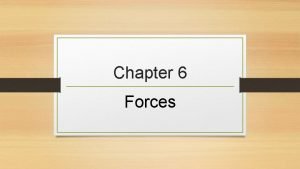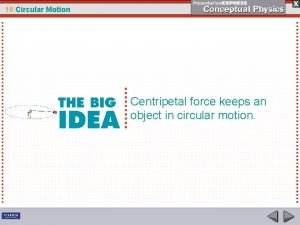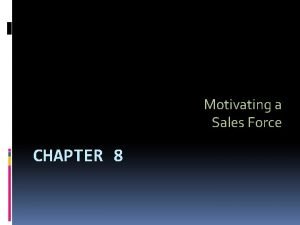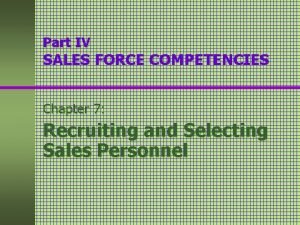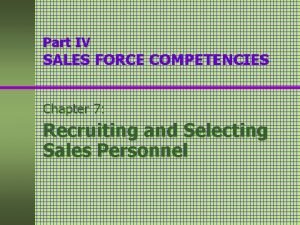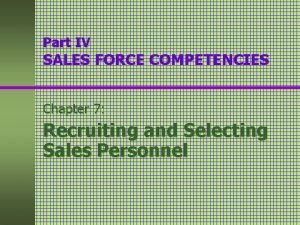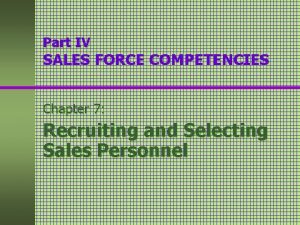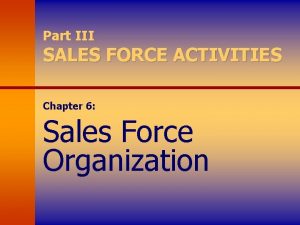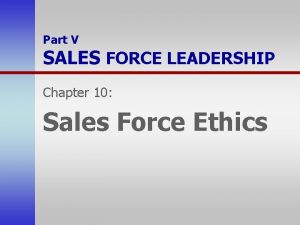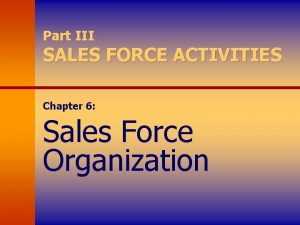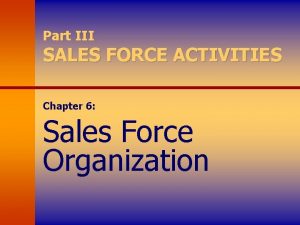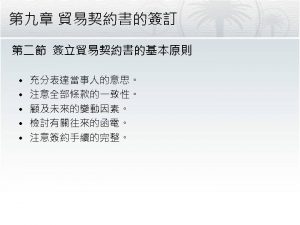Part IV SALES FORCE COMPETENCIES Chapter 8 Sales























- Slides: 23

Part IV SALES FORCE COMPETENCIES Chapter 8: Sales Training Teachers open the door. You enter by yourself. Chinese Proverb

SALES TRAINING PROCESS Planning for Sales Training Developing the Training Program Assess Training Needs What Topics? Setting Objectives Where to Train? Training Methods? Evaluating Training Follow-Up Training Setting Budget Trainers?

SALES TRAINING OBJECTIVES Why Train Salespeople? § Increase sales or profits § Create positive attitudes/improve morale § Improved customer relations § Reduce role conflict and ambiguity (turnover) § Improve efficiencies (time and territory) § Introduce new products, markets, or programs

CONVERSATIONS Sales Manager Says: “Do you think the customer will buy from us? What are the next steps? ” “You pushed the buyer pretty hard. ” “I noticed that 20% of your calls were on C accounts. ” Salesperson Says: Sales Manager Thinks: “I don’t know. ” “Why did you leave without at least scheduling a follow-up call? ” “I closed the deal, didn’t I? ” “It may be the last sale you get with this customer. What happened to building relationships? ” “I was in the area and they like to see me, so I call on them. ” “The profits from these accounts don’t even pay for the calls. You need to target better. ”

Table 8 -1 Cross-Tabulations from Company Records Average Order Size per Salesperson Experience Less than 2 year 392 2 -5 years 5 -10 years Over 10 years Regions Northeast Southeast Midwest Southwest West 593 565 470 528 520 512 421 544 21 New Customers Per Salesperson 86 Total Customers Per Salesperson 29 5 152 8 145 6 8 18 26 21 140 161 107 111 139

DETERMINING TRAINING NEEDS* Judgment of: Top Management Sales Management Training Department 68% 73% 60% Interview With: Salespeople Customers 59% 25% * Percent of firms indicating they often use these assessments to determine training needs.

DETERMINING TRAINING NEEDS* Performance Measures: Sales Volume Customer Service Other Measures: Observation of Salespeople Attitude Surveys 56% 51% 38% 28% * Percent of firms indicating they often use these assessments to determine training needs.

STEPS IN PERFORMING A TRAINING ANALYSIS 1. Interviewed key members or management to find out what changes are needed in performance of the sales force. 2. Sent an anonymous questionnaire to customers and prospects asking: 3. § What do you expect of a salesperson in this industry? § How do salespeople disappoint you? § Which company in this industry does the best selling job? § In what ways are its salespersons better? Sent a confidential questionnaire to each salesperson asking: § What information do most of our salespersons need? § What information do you want to learn better? § What skills do most of our salespersons need to improve?

STEPS IN PERFORMING A TRAINING ANALYSIS 4. Did field audits (making sales calls) with 20% of the sales force? 5. Interviewed sales supervisors. 6. Discussed and agreed on training priorities with management. 7. Determined trainable topics from information gathered in Steps 1 -5.

Table 8 -2 Average Cost and Training Period for Sales Trainees Consumer Industrial Service $5, 354 $9, 893 $9, 060 3. 40 Months 3. 80 Months

Table 8 -3 Average Cost of Training for Veteran Salespeople Median Spending $5, 365 $4, 824 $3, 752 Under $5 Million $3, 947 $5 -$25 Million $3, 902 $25 -$100 -$250 Over $250 Million Company Size

ALLOCATING TRAINING TIME Product knowledge Average 35% Market/Industry Information 15 Company Orientation 10 Selling Techniques 30 Other topics 10 Total 100%

INDUSTRY JARGON n “What does HCFA say? ” n “DRG’s are killing us. ” n “Is this level II in the POL regs? ” n “The LTC market’s future looks good. ” n “The HME industry is changing rapidly. ” n How about: – Reflotrons – Spirometry – Holters

ON-THE-JOB SALES TRAINING n 80% of a new field salesperson’s training should be focused on developing customer profiles, digging out account survey data, and building working relationships in the field. n 15% of time can then be invested in learning about how your product or service is used by existing customers. The field is the place to gain product knowledge, not from an engineer or home office instructor.

ON-THE-JOB SALES TRAINING n n Only 5% of a new field salesperson’s time, then, should be spent on developing selling skills. Again, the place to do this is face-to-face with real customers: – – n setting and testing real precall objectives asking for real opportunities to do business. Understanding what has to be done to build selling skills can be mastered in 15 minutes. Doing it takes years of actual, not simulated practice.

Table 8 -4 Media Used in Sales Training Classroom with Instructor 77% Workbooks/Manuals 54% Role Plays CD-ROM Audiocassettes Internet 44% 39% 34% 32%

EVALUATING SALES TRAINING Level of Evaluation: § Reactions: “Are trainees satisfied? ” What to Measure: § § Learning: “Did the training have its intended effect? ” § Perceptions of training Course evaluation Instructor evaluation Knowledge of course content How to Measure: § § § Survey Interview Exams Selfassessment Interview When to Measure: § § At the completion of training and at points in the future

EVALUATING SALES TRAINING Level of Evaluation: § Behavior: “Are the salespeople on the job using their knowledge and skills on the job? ” What to Measure: § § Skills Job performance Absenteeism Turnover How to Measure: § § Performance indicators Observation Managerial assessment Selfassessment When to Measure: § Over the first year after training

EVALUATING SALES TRAINING Level of Evaluation: § Results: “What effect does training have on the company? ” What to Measure: § § § Job satisfaction Customer satisfaction Sales Profits ROI How to Measure: § § § Survey Experiments Managerial assessment When to Measure: § A year after the training

EVALUATING TRAINING EFFECTIVENESS* Reactions: 86% Trainees Supervisors 68% Learning: Performance Pre-vs. Post-Training 63% 31% Behaviors: Supervisor’s Appraisal Customer Appraisal 64% 41% Results: Bottom Line 40% *Percent of firms indicating they often use these evaluations to measure training results.

Table 8 -5 Sales Training Evaluation Practices Measure Criteria Type Importance Rank Trainee Feedback Reaction 1 Supervisory Appraisal Behavior 2 Self-Appraisal Behavior 3 Results 4 Behavior 5 Bottom-Line Measures Customer Appraisal

EXPERIMENTAL DESIGN Notation O 1 = Results before sales training X 1 = Sales training O 2 = Results after sales training O 2 – O 1 = Difference in results Experimental Group O 1 Control Group O 3 Sales Training Effect (O 2 – O 1) – (O 4 – O 3) X 1 O 2 O 4

BUILDING A SALES TRAINING PROGRAM n Treat all employees as potential career employees. n Require regular re-training. n Spend time and money generously. n n Salespeople and sales managers must take the lead in developing what goes into the program. In times of crisis, increase, rather than decrease, the training program.
 Sales force organizational structure
Sales force organizational structure Sales department structure
Sales department structure Non-contact forces portfolio
Non-contact forces portfolio Vt=2pir/t
Vt=2pir/t Contact force vs long range force
Contact force vs long range force If you whirl a tin can on the end of a string
If you whirl a tin can on the end of a string Advantage
Advantage Force what is force
Force what is force What is a centrifugal force in geography
What is a centrifugal force in geography Is air resistance a noncontact force
Is air resistance a noncontact force Is electric force a conservative force
Is electric force a conservative force Centripetal force and gravitational force
Centripetal force and gravitational force Normal force and gravitational force
Normal force and gravitational force Internal forces examples
Internal forces examples Addition symbol
Addition symbol Unit ratio definition
Unit ratio definition Part part whole
Part part whole Technical description examples
Technical description examples Back bar layout
Back bar layout The phase of the moon you see depends on ______.
The phase of the moon you see depends on ______. Two way anova minitab 17
Two way anova minitab 17 Force management definition
Force management definition Aplikasi sales force automation
Aplikasi sales force automation Motivating sales force
Motivating sales force




